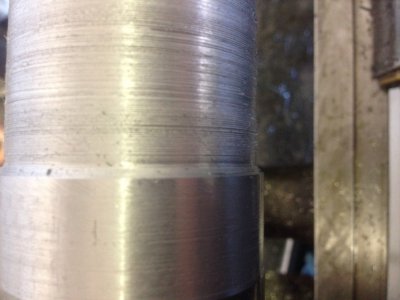Well I tried the Shear tool. All I can say is Wow it works. Very early in the process and still need to experiment with DOC and Feed and such but so far this Shear tool looks promising. Will probably still need a little emery cloth to finish but much less effort than starting with the ugly surface I had before.
Jim, the shear tool may seem like the ultimate answer at first but it
does have shortcomings including
very small DOC and feed. The cutting edge can wear quickly resulting in a tapered diameter over long workpieces. What's worse is that the wear is not usually eyeball detectable ! Takes a little magnification to see the tiny little wear spot. (This is one of the times when you
should use lots of cutting oil on 1018, to minimize the tool wear, by the way.)
This won't be a problem for general work but one of the main uses for the shear tool is not necessarily to produce a good finish but to obtain very accurate diameters, shaving off a few "tenths" at a time using the compound set at about 6 degrees off the spindle axis (google it and you'll understand the technique).
A little taper can be an important problem - for a bearing fit as an example - and then one is right back to using a scrap of emery paper to straighten out the taper

Good on ya' for trying it out, though, best way to learn is by doing ! (FWIW one time I tried a brazed carbide AL tool as a shear tool after honing the edge with a diamond lap, and got some good results. Was able to run the spindle faster with less tool wear although this won't be an advantage on your South Bend with its limited maximum RPM. I still used very small DOC and feed, however.)

